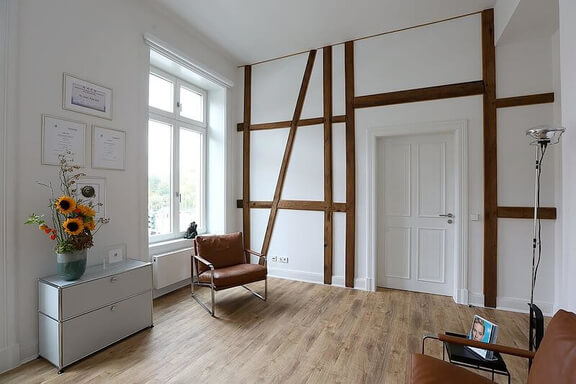Facts on Face Lifts
| Duration: | appx. 3-5 hours |
|---|---|
| Anesthetization: | genereal anaesthesiaor local anaesthesia with sedation |
| Treatment: | overnight stay in the practics |
| Strapping: | strapping on the operation day (removal in the next morning |
| Shower and hair shampooing: | from the morning after on |
| Stitch removal: | after 14 days |
| Down time: | 2 weeks |
We all get older - but do we have to look like it, too?
Getting older is no problem for many people... but looking older definitely is. They feel younger than they are, so they don't recognize themselves in the mirror anymore.
Fortunately, there are now many highly effective methods available for erasing unwanted signs of aging from the face, especially in younger years.
With time, however, the changes progress. The skin on the face loses its elasticity. Subcutaneous tissue and muscles slacken and sink downward. The face loses its resilience and its clear contours, resulting in sagging skin or what are so un-charmingly described as “hamster cheeks”.
But these changes can also be treated in a harmonious way. A good face lift can often turn back years on the clock, as though the ravages of time had been a bit slower and gentler. And thanks to modern face lift techniques, you can enjoy this effect without losing “your” individual face or its expressive power... provided the face lift is done well, that is, by an aesthetic plastic surgeon who knows his craft well.
FACE LIFT OR MINI-LIFT? – LIFTING OR SIMPLY TIGHTENING?
The decision to get a face lift is often not an easy one. Is it really an option for me? And, if so, which method is best? “Mini”-lift? “SMAS” face lift? Which technique is right for me? How extensive will the surgery be? What risks will it involve?
And then there’s the worry about looking unnatural, about having a “mask” face... and, indeed, that worry is not entirely unfounded. After all, not all face lifts are done the way they’re supposed to be. Many surgeons merely pull the skin toward the back (skin tightening) rather than lifting the face back to its original position (face lifting).
Obviously, just pulling on the skin won't give you natural-looking results, because you’ll lose your characteristic features and your natural facial expressions. The media often shows us these types of negative examples, of artificial or hardly recognizable faces. But none of that has anything to do with what we consider modern face lift surgery.
Modern face lift methods using SMAS lifting technology (see below) allow us to make a face more attractive while preserving its characteristic features. We want your face to look fresher and more attractive, but not surgically altered. Your face can reveal many things about you, but your age need not necessarily be one of them... nor the fact that you’ve had an operation.
FACIAL TREATMENT OR FACE LIFT? - AND WHICH FACE LIFT IS RIGHT FOR WHICH PERSON?
Not all face lifts are created equal. There are many different face lifting methods and surgical techniques.
Some of the procedures called “face lifts”, upon closer examination, turn out not to be actual face lifts at all. Compared to the SMAS lift, terms like “mini,” “gentle,” “bio-lifting” or “weekend” lifting may make a treatment seem harmless and thus attractive.
But just these treatments are the ones patients need to be cautious about: All too often, the actual procedure in question is not a real face lifting, but merely skin tightening, with all the potential (and potentially irreversible) consequences it entails.
Here at our practice in Hamburg, we know that not all face lifts are the same, which is why we modify our techniques to fit your individual needs. After all, every face is unique, so every facial treatment needs to be adapted to fit its unique characteristics.
Oftentimes, combining the operation with non-surgical treatments (such as facial volume enhancement or injectable wrinkle fillers) can be very useful to enhance and round out the results of the face lift.
And in more than a few cases, face lift operations are not even necessary— because we can achieve wonderful results using non-surgical injection-based treatments or volume enhancers.
FACE LIFTS – SURGICAL TECHNIQUE
Face lifts are designed to make the face look fresher and more attractive, and ideally younger as well. The procedure lifts sagging skin, and shapes and restores lost facial contours.
All this is achieved using an incision made in the shadow lines around the ear. From there, the surgeon lifts the skin of the face and the connective tissue underneath as far as is necessary in that individual case, in order to expose the firm SMAS tissue (see below) underneath. Next, the sagging skin is lifted and re-contoured, and then fixed into place with the help of the SMAS tissue to retain its new shape and position.
This SMAS lifting technique prevents unnecessary tension on the skin of the face, which provides natural-looking results and is also essential to proper wound healing. When the scars have healed well, the access incisions close to the ear will be practically invisible later on, whereas the improved facial contours will be perfectly evident.
Read on for descriptions of a few of the most important face lift methods.
SMAS LIFT – NATURAL LIFTING THAT LASTS
The S. M. A. S. is key to a harmonious appearance, natural facial expressions, and long-lasting results following a face lift.
SMAS stands for superficial musculo-aponeurotic system, and describes a layer of muscular connective tissue located in the subcutaneous layer of our face and neck skin. This layer of tissue is thin, yet has amazingly high tensile strength, and it is this tensile strength that makes the SMAS so valuable to face lifting procedures.
The SMAS makes it possible to lift a sagging face in the most literal sense of the word. This SMAS lifting technique prevents unnecessary tension on the skin of the face, which is the most important key to natural results and inconspicuous scars.
This is why the SMAS lifting technique is always one component in all of our various face lifting methods. It allows us to lift the face effectively (face lift), rather than merely tightening it (skin tightening).
DEEP PLANE FACE LIFT
Just as the name “deep plane” suggests, this lifting procedure is performed on a deeper layer of the face. The advantage this provides is that the outer skin need not be lifted up as far; connections to the subcutaneous tissue remain largely intact, so your characteristic features do as well. The lifting effect on this deeper layer is also achieved by using the SMAS lifting technique.
This method is particularly suitable for younger patients and patients whose skin is in good condition.
VOLUME FACE LIFTING
Our facial volume shifts over time: slowly at first, and then in clearly visible ways. Volume deficits develop in certain locations of the face as well. Conventional face lifting techniques cannot compensate these changes by themselves, but a volume face lift can help address both issues effectively.
Conventional face lifting involves removing excess subcutaneous tissue; In our volume face lifts, we harvest this tissue and distribute it precisely for aesthetic effect, such as near the zygomatic arch or around the cheeks. There, the tissue helps shape the face and improve its contours. For additional effects this procedure can also be combined with additional volume treatments, such as volume injections.
SUPEREXTENDED FACE LIFT
It may sound like major surgery at first, but for many patients, it is the most sensible solution. The reason for this is, ultimately, the nature of our bodies. Over the course of our lives, our faces change—not in isolated areas, but ubiquitously, i.e., overall.
Our faces age more or less everywhere, so if we address the situation in individual areas of the face while leaving others as they are, it may disrupt facial aesthetics. Rather than seeing a harmonious whole, we notice immediately that something isn’t quite right. This is why it makes sense to think in aesthetic units, and to beautify the entire face as a whole.
TREATMENT PROCESS
Proper medical treatment requires solid knowledge and extensive experience. Optimum treatment processes also require sufficient time.
And we take that time for you. Our practice in Hamburg always schedules generous amounts of time in for each treatment, so that we can ensure that we are not under time pressure with any of our patients.
Should you decide to undergo surgery/treatment, we will go over the essentials with you again during the second consultation (also called the surgery planning meeting). Our surgical and anesthesia teams will help you prepare for surgery in order to ensure your safety.
After treatment, our experienced surgical team or night team will personally take care of you. You will receive important information and patient guides on post-surgical care, and we will work with you directly to set up additional examination or treatment appointments.
FACIAL TREATMENTS AND FACE LIFTS BY A SPECIALIST
Thanks to his specialization in facial surgery, Dr. Arlt has many years of experience with facial treatments and face lifting procedures. Face lifting surgery is his second area of specialization (nasal surgery being the first) and thus numbers among his main treatment focuses at his practice in Hamburg.
At your initial consultation meeting here in our Hamburg practice, we will start by analyzing your diagnostic findings precisely and explaining the options that make most sense in your case.
After that, you can discuss the right treatment methods for you with Dr. Arlt, and then go home to weigh the alternatives at your leisure. You are welcome to bring your partner to your second in-person appointment with Dr. Arlt, at which we will discuss the options explained before in greater detail and address any questions you may have.
Contact
Dr. Axel Arlt
Practice community
Esplanade 31 / Ecke Stephansplatz
D - 20354 Hamburg
Phone: +49 (0)40 - 413 55 66 9
Mail: info@dr-axel-arlt.de


